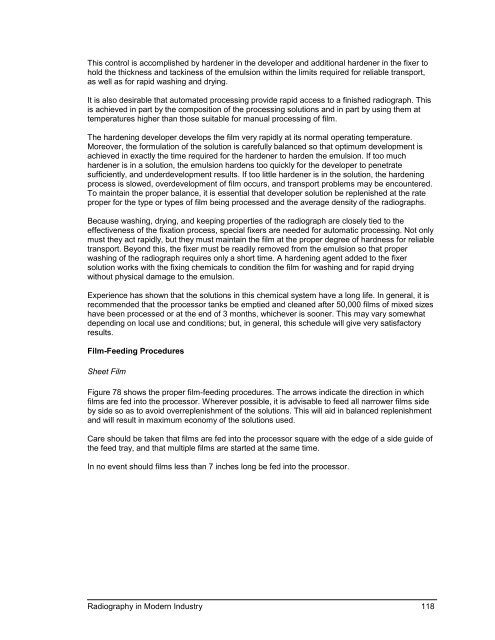Radiography in Modern Industry - Kodak
Radiography in Modern Industry - Kodak
Radiography in Modern Industry - Kodak
You also want an ePaper? Increase the reach of your titles
YUMPU automatically turns print PDFs into web optimized ePapers that Google loves.
This control is accomplished by hardener <strong>in</strong> the developer and additional hardener <strong>in</strong> the fixer tohold the thickness and tack<strong>in</strong>ess of the emulsion with<strong>in</strong> the limits required for reliable transport,as well as for rapid wash<strong>in</strong>g and dry<strong>in</strong>g.It is also desirable that automated process<strong>in</strong>g provide rapid access to a f<strong>in</strong>ished radiograph. Thisis achieved <strong>in</strong> part by the composition of the process<strong>in</strong>g solutions and <strong>in</strong> part by us<strong>in</strong>g them attemperatures higher than those suitable for manual process<strong>in</strong>g of film.The harden<strong>in</strong>g developer develops the film very rapidly at its normal operat<strong>in</strong>g temperature.Moreover, the formulation of the solution is carefully balanced so that optimum development isachieved <strong>in</strong> exactly the time required for the hardener to harden the emulsion. If too muchhardener is <strong>in</strong> a solution, the emulsion hardens too quickly for the developer to penetratesufficiently, and underdevelopment results. If too little hardener is <strong>in</strong> the solution, the harden<strong>in</strong>gprocess is slowed, overdevelopment of film occurs, and transport problems may be encountered.To ma<strong>in</strong>ta<strong>in</strong> the proper balance, it is essential that developer solution be replenished at the rateproper for the type or types of film be<strong>in</strong>g processed and the average density of the radiographs.Because wash<strong>in</strong>g, dry<strong>in</strong>g, and keep<strong>in</strong>g properties of the radiograph are closely tied to theeffectiveness of the fixation process, special fixers are needed for automatic process<strong>in</strong>g. Not onlymust they act rapidly, but they must ma<strong>in</strong>ta<strong>in</strong> the film at the proper degree of hardness for reliabletransport. Beyond this, the fixer must be readily removed from the emulsion so that properwash<strong>in</strong>g of the radiograph requires only a short time. A harden<strong>in</strong>g agent added to the fixersolution works with the fix<strong>in</strong>g chemicals to condition the film for wash<strong>in</strong>g and for rapid dry<strong>in</strong>gwithout physical damage to the emulsion.Experience has shown that the solutions <strong>in</strong> this chemical system have a long life. In general, it isrecommended that the processor tanks be emptied and cleaned after 50,000 films of mixed sizeshave been processed or at the end of 3 months, whichever is sooner. This may vary somewhatdepend<strong>in</strong>g on local use and conditions; but, <strong>in</strong> general, this schedule will give very satisfactoryresults.Film-Feed<strong>in</strong>g ProceduresSheet FilmFigure 78 shows the proper film-feed<strong>in</strong>g procedures. The arrows <strong>in</strong>dicate the direction <strong>in</strong> whichfilms are fed <strong>in</strong>to the processor. Wherever possible, it is advisable to feed all narrower films sideby side so as to avoid overreplenishment of the solutions. This will aid <strong>in</strong> balanced replenishmentand will result <strong>in</strong> maximum economy of the solutions used.Care should be taken that films are fed <strong>in</strong>to the processor square with the edge of a side guide ofthe feed tray, and that multiple films are started at the same time.In no event should films less than 7 <strong>in</strong>ches long be fed <strong>in</strong>to the processor.<strong>Radiography</strong> <strong>in</strong> <strong>Modern</strong> <strong>Industry</strong> 118
















